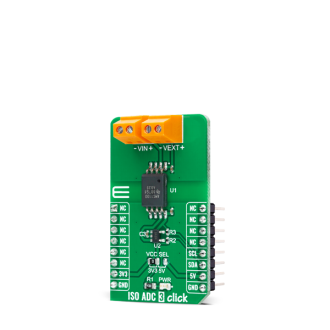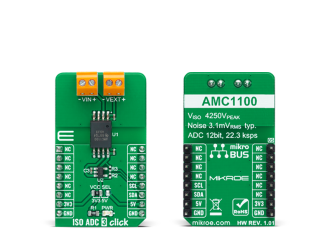
We strongly encourage users to use Package manager for sharing their code on Libstock website, because it boosts your efficiency and leaves the end user with no room for error. [more info]

Rating:
Author: MIKROE
Last Updated: 2020-12-23
Package Version: 1.0.0.0
mikroSDK Library: 1.0.0.0
Category: ADC
Downloaded: 2798 times
Not followed.
License: MIT license
ISO ADC 3 Click is a compact add-on board that contains a single-channel precision isolation amplifier.
Do you want to subscribe in order to receive notifications regarding "ISO ADC 3 click" changes.
Do you want to unsubscribe in order to stop receiving notifications regarding "ISO ADC 3 click" changes.
Do you want to report abuse regarding "ISO ADC 3 click".


Library Description
The library covers all the necessary functions that enables the usage of the ISO ADC 3 Click board™. It offers reading raw data from output register and calculations that result in relatively accurate measurement of the ADC's voltage level.
Key functions:
uint16_t isoadc3_read_data ( ); - Function is used to read raw data from MCP3221.uint16_t isoadc3_read_voltage ( uint16_t v_ref ); - Function is used to calculate the ADC's voltage level.Examples description
The application is composed of three sections :
void application_task ( )
{
voltage = isoadc3_read_voltage( v_ref );
WordToStr( voltage, log_txt );
mikrobus_logWrite( "ADC voltage Level: ", _LOG_TEXT );
mikrobus_logWrite( log_txt, _LOG_TEXT );
mikrobus_logWrite( "mV", _LOG_LINE );
mikrobus_logWrite( "------------------------", _LOG_LINE );
Delay_ms( 1000 );
}
Other mikroE Libraries used in the example:
Additional notes and informations
Depending on the development board you are using, you may need USB UART click, USB UART 2 click or RS232 click to connect to your PC, for development systems with no UART to USB interface available on the board. The terminal available in all MikroElektronika compilers, or any other terminal application of your choice, can be used to read the message.